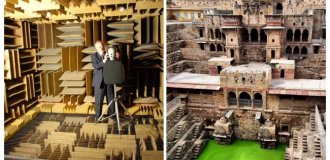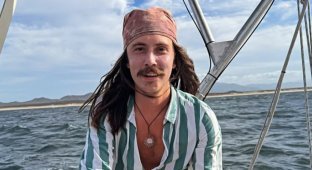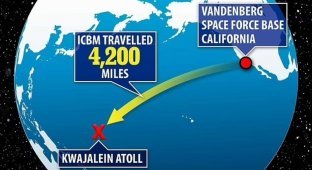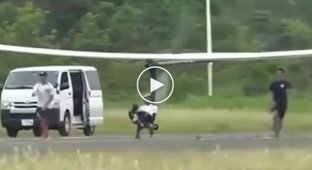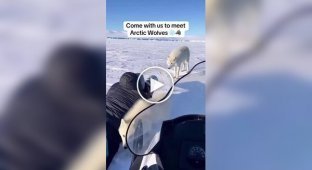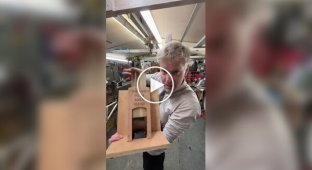Top-secret project "Azorian": how the Americans raised a sunken Soviet submarine from a depth of five kilometers (9 photos)
It took 6 years to prepare for this operation. 
The K-129 was a diesel submarine from the first generation of Soviet ballistic missile submarines. In February 1968, it went on duty in the Pacific Ocean north of Hawaii. The goal was to approach the American shores and launch missiles in case of war with the United States. 
On March 11, the submarine stopped communicating. At first, the headquarters did not see anything critical in this: to send a signal, the submarine had to surface or release a towed antenna. Both options could unmask it, so the military leadership decided that the ship's commander was simply preparing to contact them in the near future.
Two weeks passed, and the signal from the K-129 still did not arrive.
That's when the military pulled ships and reconnaissance aircraft to the northern part of the Pacific Ocean and began searching for the submarine. The leadership understood that it was most likely lying on the bottom, so they looked for the slightest signs of disaster. For example, an oil slick on the surface. The search ended in nothing.
That's when the Americans got involved.
They noticed the intense activity of the Soviet Navy and analyzed the recordings of the SOSUS (Sound Surveillance System). This is a network of sonar microphones, they are scattered across different parts of the ocean. The specialists listened to the March recordings and found an unusual noise. Something like a powerful bang or implosion - an explosion directed inward. 
After that, the exact location of the sunken submarine was determined: it lay at a depth of almost 5 kilometers, halfway between Hawaii and the Northern Kuril Islands. The USSR was searching hundreds of miles from this place. Then they launched a special-purpose nuclear submarine Halibut with photo and video cameras of the FISH system. And they received many pictures from the accident site. Experts studied them, and the military decided to raise the submarine. To examine its nuclear missiles, cryptographic equipment and other elements. 
This operation was supervised by the CIA, it was called "Project Azorian". A legend was prepared for it: supposedly geologists announced that bottom ferromanganese deposits were discovered in that part of the Pacific Ocean. Therefore, the ship Hughes Glomar Explorer headed there - on board was Howard Hughes, a billionaire and a person close to military structures. The work was carried out on behalf of his mining company. 
It took 6 years to prepare. And in July 1974, the ship arrived at its destination. There was a slot in the bottom of the Glomar Explorer, tens of meters long, and above it were cranes and other special equipment.
It looked like this: 
The device was nicknamed "Clementine" - when descending to the depth, a vertical steel pipe about half a meter thick was attached to it. Then another pipe was screwed to this pipe, the same, and as a result, the length of this suspension reached several kilometers. 
"Clementine" reached the bottom and hooked the front part of the submarine. But on the way to the surface, one of the claws of the device broke off and K-129 sank again. They managed to capture only the 12-meter long bow segment. Later, the Americans assured the public that those fragments of the submarine were not raised again. Although this is debatable - after all, there was a conning tower, missiles and a launch silo.
But that 12-meter fragment contained a lot of technical documentation, including instructions for operating ballistic missiles. The remains of six dead Soviet sailors were also found there. They were given a funeral service and, according to maritime custom, buried in the ocean.
As for the reasons for the death of the submarine, there are two main versions. The first was voiced by Soviet Admiral Viktor Dygalo: in his opinion, K-129 collided with the American submarine Swordfish. At the time of the disaster, it was in that part of the Pacific Ocean. Later, the press got pictures of the submarine in the port with a bent periscope.
And the second version was defended by Captain Jack Newman, a submariner from the USA. He listened to the recordings of the SOSUS system and reconstructed those events: on March 11, the ship's captain Vladimir Kobzar ordered several sharp turns and listened to the blind spots behind the submarine with a sonar. Then he allegedly ordered to surface to periscope depth and raise the RDP. This is a device that ensures the engine operates in an underwater position, through it air is supplied to the diesel engine. 
And that day there was a strong storm at sea. According to Newman, one of the waves reflected off the wheelhouse and flooded the RDP. He allows for this, but in the case of the K-129, the RDP could have been damaged. Water got into the battery compartment through it and caused a short circuit. In addition to breaking the batteries, this caused a sharp release of toxic gases and a fire. 
But we will only know the exact reason when underwater archaeologists raise the remaining parts of the K-129 from the bottom. The Americans took only a small part of them and in 1974 officially closed the Azorian project. Although a significant part of its documentation is still classified.




